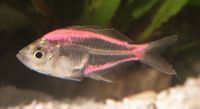
Painted Parambassis ranga specimen. A
needle was used to inject the pink dye.
The term painted fish refers to ornamental
aquarium
fishes which have been artificially coloured to appeal
to consumers. This artificial colouring, also known as
juicing, is achieved by a number of methods, such as
injecting the fish with a hypodermic syringe containing
bright fluorescent colour dye, dipping the fish into a dye solution, or feeding the fish
dyed food.
This process is usually done to make the fish a brighter
color and more attractive to consumers. The coloring of the
fish is not permanent, and usually fades away in six to nine
months.
Methods
Information on methodology is sometimes scanty. However,
it is widely accepted that a common method is injection via
syringe. Generally, fish are injected multiple times.[1]
Fish may also be dipped in a caustic solution to strip
their outer slime coat, then dipped in dye. This method is
reported to have a very high mortality rate.[2]
Many varieties of "colour-enhancing" foods for aquarium
fishes are available to the consumer. Generally, these foods
contain natural dyes such as beta
carotene and are not harmful to fish, although as with
other dye methods, the effect is temporary. One source
reports that harmful dyes are sometimes used by wholesalers,
however.[2]
Fish can also be tattooed using a low-intensity laser
with a dye, a process developed for fisheries scientists but
now applied to ornamental fish.[3]
It has been rumoured that some brightly colored "male"
fishes in dealer tanks may actually consist of both males
and females treated with hormones so all the fish, males and
females alike, show male breeding colors even out of
breeding season.[4]
Varieties
Some species, such as albino
Corydoras and "painted" glassfish, are injected with dye
using a hypodermic needle. In more recent times (2004-2005),
injection dyed albino Plecostomus and rift lake cichlids have also become available. Other than the
Indian Glassy Fish, most dyed fish are albinos.
Some commonly painted species
- Indian Glassy Fish (Parambassis ranga). Tradename:
Painted glassfish; Disco Fish; Colored Glass Tetra.
Black tetra (Gymnocorymbus ternetzi). Tradenames: Berry
Tetra; Painted Tetra.
Oscar (Astronautus ocellatus). Tradenames: Blueberry
Oscar; Strawberry Oscar.
Corydoras species
African Rift Lake cichlids, such as Pseudotropheus.
Tradenames: Ice Blue Albino Cichlid; Zebra Ice Albino
Cichlid.
Suckermouth catfish (Hypostomus plecostomus). Tradenames:
Patriotic Suckerfish; Mixed Color Suckerfish.
Parrot cichlid (Amphiliphus citrinellus x Heros severus).
Tradenames: Jellybean Cichlid; Cotton Candy Cichlid.
Goldfish (Carassius auratus). Tradenames: Jellybeans;
Icepops.[5]
Health hazards to painted fish
Many dyed fish die during this stressful, painful,
process and those that do survive often are susceptible to
disease. For example, one source reports a 300% increase in
diseases such as Lymphocystis, Ichthyophthirius and finrot in painted aquarium populations compared to
unpainted populations, possibly due to infection by dirty
syringes. In addition, fishes injected with dye often die
without apparent external disease symptoms, presumably due
to kidney disease caused by injection.[6]
Efforts to stop fish painting
Some members of the aquarium trade want to ban this
practice. For example, the British publication Practical
Fishkeeping started a campaign in 1996 to ask retailers to
stop selling dyed fish, which led to a significant decrease
in the number sold in the United Kingdom. Practical
Fishkeeping has launched a similar campaign with a global
scope and maintains a register of stores which do not stock
dyed fish.[7] The Royal Society for the Prevention of
Cruelty to Animals (RSPCA) regards the practice as cruel and
unnecessary cosmetic mutilation. A campaign in Australia and
in the UK has limited the sale of these fish. Dyed fish are
still available and are generally imported from south-east
Asia.
In February 2006, the UK's Department for Environment,
Food and Rural Affairs
(Defra) confirmed that it will not be making it illegal to
sell dyed fish in the UK under the forthcoming Animal
Welfare Bill.[8]
References
- ^ Dr
Stan MacMahon and Dr Peter Burgess.
Why it's cruel to dye. Practical Fishkeeping.
Retrieved on 2006-05-19.
- ^
a b
Shirlie Sharp.
Death by Dyeing. About.Com. Retrieved on 05-19-2006.
- ^
Company offers custom fish tattoos with laser (2006-02-23).
Retrieved on
2006-05-19.
- ^
Steroids and Livebearers. The Krib. Retrieved on
2006-05-19.
- ^
Shades of Death. Retrieved on
05-19-06.
- ^
Jim Greenwood, B.V.Sc..
What's wrong with a painted angel?. Retrieved on
2006-05-18.
- ^
Dyed Fish Campaign. Retrieved on
2006-05-19.
- ^
Dyed fish to remain legal (2006-02-17). Retrieved on
2006-05-19.




